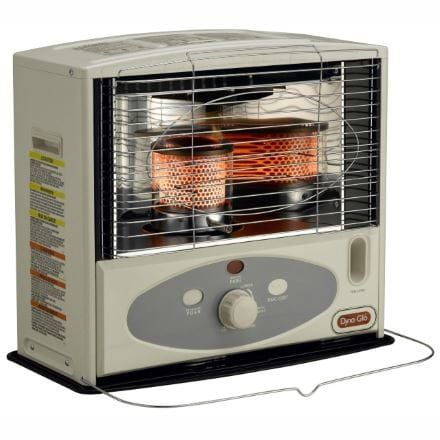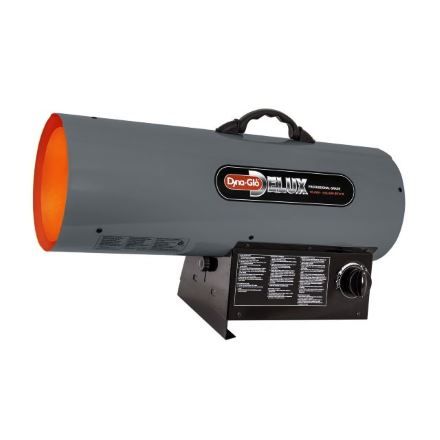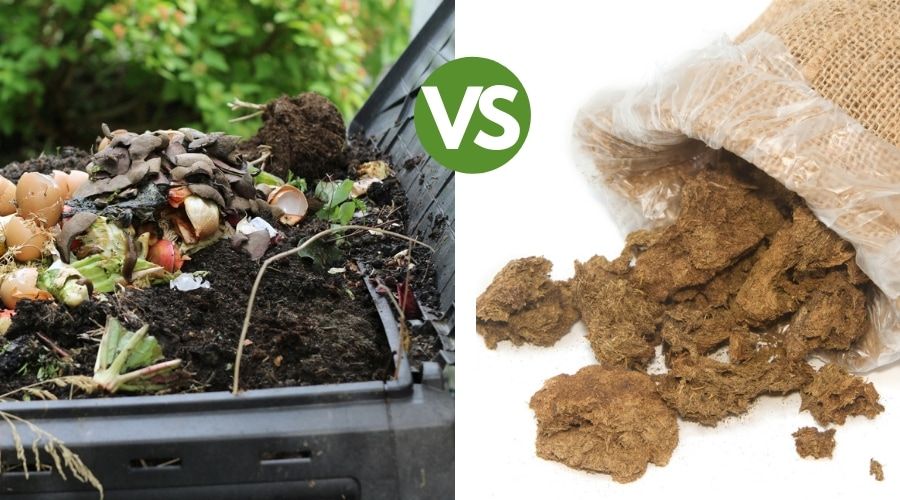Working in your garage during the cold winter months can be uncomfortable, to say the least. And if you need to be spending any amount of time working on vehicles, or any other project you have going, you probably have considered adding some sort of garage heater to the space.
Fuel fed heat, such as kerosene or propane heaters for the garage, are fairly standard products which are affordable and can be easily chosen to accommodate the space you need to warm. I’ve outlined what differences exist between the two in order to provide you with the information to choose which is best for you.
KEROSENE VS PROPANE COMPARISON TABLE
|
|
Features |
|---|---|
|

|
|
|

|
|
Kerosene Heaters
PROS
- Burns fuel efficiently
- Heats quickly
- Easy to use and move to where it’s needed
CONS
- Could be a fire hazard
- Poor ventilation can build up carbon monoxide built up
Kerosene heaters are excellent choices for both indoor and outdoor use, and are considered safer choices compared to similar gas fueled versions. Plus, they are portable and can be moved from one place to the next relatively easily. They also do not need any electricity to run, and are a great product to have around for if you lose electricity and heating.
Types
There are a few different types of heater you can choose from that use kerosene as its fuel source. Depending on how much space you need to heat, what use you need the heater for, and your amount of ventilation will help you determine which heater is best for your use.
- Radiant
Radiant heaters use a circular wick to transport fuel to the burner unit (also called a catalytic converter). These warm the objects that are closest to them, with objects further away from taking longer to warm. This works through the reflection of infrared heat waves and warms instantly. They can only project the heat forward.
- Forced Air
Forced air heaters use a cylinder type body that forces air heated by combusted kerosene (or diesel as many can be run on multiple fuel types) into the space you are heating. Like radiant heat, it is directional, but warms the air, rather than object surfaces, and thus has a larger heat spread, and can be quite effective very quickly. These can get rather loud when used as they are a bit like a jet engine.
- Convection
Usually, these have a circular tower design with a safety grillwork in place as they heat in all directions. These are very efficient and use a similar startup as radiant heaters, but with very little flame except at startup. These warm large areas quickly and are considered a safe heater, but still must be kept at least 2 feet from all surfaces.
Costs
Kerosene heaters require a quality grade kerosene to run off of if you want to avoid anything but the cleanest burn. Plus, the better the grade, the more efficient your burn will be - saving you money and providing a cleaner, better heat coverage. Since your likely placement of the heater is indoors, this is an important consideration.
Fuel prices fluctuate as the prices of oil fluctuate, and kerosene prices will reflect this as well. This means that it may cost you a different price from one season to the next to heat your space. On average many people report burning approximately 0.2 gallons per hour using a convection heater. There are many variables to consider in this equation, however, such as how many BTU’s are being used, insulation, and ventilation.
Concerns
Although kerosene heaters are popular, efficient, and portable heaters- there are a few things you should consider if you are not already familiar with them. First off, heat output might not be easily controlled depending on the model you purchase. For smaller spaces, this may mean it heats up fast but will need to be turned off as thermostat controls may not be available.
They also need to be filled with fuel, and wicks needs to be checked for cleanliness and changing- as a dirty wick will create a sooty environment. Plus, you are working with a flame that can create a fire hazard, and also vent burner emissions into your space despite safety features.
Unvented heaters need to be allowed ventilation specific to the manufacturer's recommendations to avoid carbon monoxide buildup and efficient use. Depending on how you provide consistent ventilation (such as cracking a window, or garage door) may create a cooling effect and affect the heater efficiency.
Propane Heaters
PROS
- Heats quickly
- Very cost effective
- Burns clean and efficiently
CONS
- Portable models require good ventilation
- May not work properly above 4500 feet elevation
Like kerosene heaters, propane garage heaters are fuel powered and can be purchased according to what types of spaces you need heated. Unlike kerosene, these heaters can be both portable or fixed into place and can be hooked into existing propane supplies your property may already have or work directly off a portable tank.
Types
Propane heaters are available a few different shapes and sizes as well and use the same principles as any other fuel-powered heater to heat your house. Certain propane heaters may use a fan to circulate heated air which requires an electrical hookup, and thermostats are often used with them as well- which may also require electrical capabilities.
- Radiant
Radiant propane heaters use the gas-fired heater to warm emitter tubes. As these tubes heat they radiant heat to the objects surrounding them. This creates instant warmth and does warm quickly, but objects further away will take longer to warm. These can either be portable or mounted on walls and ceilings.
- Forced Air
Like kerosene forced air heaters, these are powerful units that force air in one direction. They are portable and heat spaces very quickly by warming the air in front of the unit. These are often noisy to heat, but very convenient and easy to use and make popular heaters when the need to warm spaces quickly is a must.
- Convection
Also similar to kerosene in design, these heaters provide heat in all directions as they are also upright in nature. These warm the air surrounding them, and although are considered safe to use, do require proper ventilation and space around them due to how they are built.
- Mounted
Propane heaters can be installed into your spaces more permanently as well and tapped into existing propane lines, or a separate cylinder. These are often chosen when large spaces need to be heated more consistently, or for commercial uses. They also usually require professional installation.
Costs
Propane is an efficient and cost-effective heating measure, but it is dependent upon fuel prices. Propane costs will fluctuate with fuel prices changes, but unlike kerosene is more readily available and easier to get. Depending on your heating choice, you also can set up regular delivery of propane directly to you.
You also do not have to worry about the type of propane you are getting. There are no quality differences that could be a concern and cause your heater to run less efficiently, making this a hassle-free choice. Since most propane heaters allow you to better control how much heat is being put out, how much propane you burn through is entirely in your control. Higher heat outputs will use more, while a lower consistent burn will use less. Some units also use an automatic shutoff.
Concerns
Obviously if you do not have propane you cannot use your heaters. Unlike kerosene, you may not be able to see how much propane you have left since you cannot exactly open the tank to look inside. Some tanks are equipped with a meter to help you determine what is left in the tank, but these are not a guarantee, and may not always be that accurate.
Fittings should always be tight and checked for leaks. Since propane is combustible, you want to ensure there is not leak occurring as it can cause an explosion if it comes in contact with an open flame. Incomplete combustion can also release carbon monoxide, so ventilation is also an important consideration within enclosed spaces.
Conclusion
Both propane and kerosene heaters are efficient, cost-effective sources for garage warmth. Although they have their differences, choosing between the two simply comes down to what specific needs you have for it, as well as personal preferences. In choosing a garage heater, kerosene vs propane, you should weigh the space you need heated, versus the abilities you have to run the various types each is available in.





